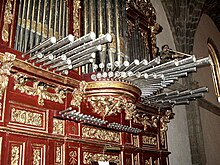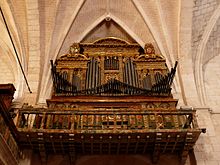Spanish trumpet
The Spanish trumpet is an organ register that is arranged horizontally in the organ's prospect .
The register in historical Spanish organs
Horizontal reed pipes became widespread in the second half of the 17th century on the Iberian Peninsula and from then on were hardly missing in any of the organs in this area. The oldest known mention concerns a trumpet in the Eibar organ in 1659. The visual impression of such registers seems to have been calculated from the start. Joseph de Echevarría , the first organ builder known to have horizontal tongues, compares it to " artillery ". Horizontal reed pipes are also found in organs built in the Spanish and Portuguese colonies of the time.
In traditional Iberian organs, in which the manuals are divided between c¹ and cis¹, a fully developed "trompetería" (or "lengüetería") is found in the bass half (B) horizontal trumpets of 8 ′, 4 ′ and 2 ′ and in the Discant half (D) horizontal trumpets of 16 ', 8' and 4 '. The characteristic sound of these lingual pipes, which are almost always equipped with beating tongues, results from the fact that the sound waves from these pipes can propagate into the room without any obstacles (other pipes, organ cases). In small instruments, but also in instruments from the early days of horizontal tongues, there is often only one horizontal trumpet 4 'B / 8' D and a horizontally arranged shelf-like register 8 'B / D.
An instrument from the late Baroque period in France (organ in St. Maximin, Département Var ; built by Jean Esprit Isnard , completed in 1773) has been preserved, which has two horizontal trumpets 8 ′ each only in treble position.
Historical Spanish organs differ from modern organs with the register "Spanish trumpet" in the construction, setup and tuning of the instrument: As the historical organs are either attached to the side wall of the church as a swallow's nest organ or - typically in monastery churches or cathedrals - above the choir stalls of the monk's choir are set up or - typically in smaller churches - are rotated by 90 ° on the side wall of the west gallery compared to the usual setup, the horizontal trumpets are always at right angles to the main direction of the church. As a result, the sound is reflected several times before it reaches the audience in the nave. Further reasons for the significantly softer sound are the mid-tone tuning typical of these organs , a low wind pressure (around 60 mm WS) and thin reeds .
Spanish trumpets in modern organs

After Aristide Cavaillé-Coll , who was familiar with Spanish organ building, used "Trompettes en chamade " in French organ building in the 19th century, horizontal reed stops have been increasingly built in other countries since the 2nd half of the 20th century. As at the time of their invention, they are often used because of their special optical impression. In addition, tonal aspects also play a role in modern organ building. As a rule, it is the conventional modern design, which differs from the old Spanish version, so that the term "horizontal trumpet" seems more appropriate.
In modern organs, the trompetería is either designed as a split register based on the Iberian tradition or the horizontal reed stops are built continuously like all other stops in the respective organ. In their construction, they are usually not based on the classic Spanish horizontal rolling, but modern. This results in a considerably more “massive” sound character than with historical specimens. The trompetería is often arranged as a separate work either with its own manual or without its own manual with links to the existing manuals. Outside the Iberian Peninsula, there is only one Spanish trumpeteria that was originally made in Spain: It is located in the Marienstatt Abbey in the Westerwald. In Germany there are also two organs of this type manufactured after the turn of the millennium in the Neustädter Church in Hanover and in the Evangelical Church in Züsch .
register
Common names are:
- Trompeta de batalla (8 ′ B / D)
- Trompeta de campaña (8 ′ B / D)
- Bayjoncillo (4 ′ B)
- Clarín claro (8 ′ D)
- Clarín de batalla (8 ′ D)
- Clarín de campaña (8 ′ D)
- Clarín en quincena (2 ′ B)
- Trompeta magna (16 ′ D)
- Trompeta imperial (32 ′ D or 16 ′ D)
- Trompeta quinta ( 5 1 ⁄ 3 ′ D, B / D or without division, rarely)
- Chamade (16 ′, 8 ′ or 4 ′ with or without division)
- Trompette en chamade (16 ′, 8 ′ or 4 ′, with or without division)
- Spanish trumpet (16 ′, 8 ′ or 4 ′, with or without graduation)
- Royal Trumpet (16 ′, 8 ′ or 4 ′, with or without division, in modern organs often as a high pressure register)
Occasionally there are also horizontal trumpets 16 ′ in bass with half the bell length (trompeta bastarda) . A trompeta magna can also mean an internal trumpet 16 ′ (D or B / D, then B with half the cup length). With Trompeta imperial a standing inside the trumpet 32 'or 16 D' D can be meant. Trompeta real is almost always an internal trumpet, usually 8 ′, which is present in almost every organ with horizontal reeds.
The trompetería often also includes shelf-like lingual registers (Dulzaina, Orlos, Viejas, Viejos) with short, conical or cylindrical, sometimes partially covered, cups in positions 16 ′ B / D, 8 ′ B / D, 4 ′ B / D (D rarely ) and 2 ′ B.
Sound samples
Played on the organs of the church "San Juan Bautista" in Marchena , Spain :
- (470 kB)
- (614 kB)
See also
literature
- Roland Eberlein : Organ register. Their names and their history . 3. Edition. Siebenquart, Cologne 2016, ISBN 978-3-941224-00-1 , p. 616-617 .
- Hans Klotz : The book of the organ. About the nature and structure of the organ work, organ maintenance and organ playing. 14th edition. Bärenreiter, Kassel u. a. 2012, ISBN 3-7618-0826-7 .
- Rudolf Reuter : Orgeln in Spanien (= publications of the organ science research center in the musicology seminar of the Westphalian Wilhelms University. No. 14). Bärenreiter, Kassel u. a. 1986, ISBN 3-7618-0769-4 .
- James Wyly: Historical Notes on Spanish Façade Trumpets. In: The Organ Yearbook. Vol. 8, 1977, ISSN 0920-3192 , pp. 41-55.
- Ferdinand Klinda: organ registration. Sound design of organ music. Breitkopf & Härtel, Wiesbaden 1987, ISBN 3-7651-0212-1 (disposition of the organ in St. Maximin, Var, with explanations).




